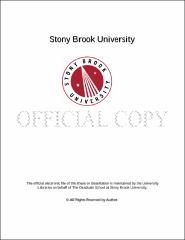| dc.identifier.uri | http://hdl.handle.net/11401/76573 | |
| dc.description.sponsorship | This work is sponsored by the Stony Brook University Graduate School in compliance with the requirements for completion of degree. | en_US |
| dc.format | Monograph | |
| dc.format.medium | Electronic Resource | en_US |
| dc.language.iso | en_US | |
| dc.publisher | The Graduate School, Stony Brook University: Stony Brook, NY. | |
| dc.type | Dissertation | |
| dcterms.abstract | Neurons in the gustatory cortex (GC) encode chemosensory information, palatability and expectation. The representation of these variables is believed to result from the integration of thalamic and limbic inputs. While the limbic-cortical pathway is well studied, very little is known about the gustatory thalamus (VPMpc). To understand the role of VPMpc in taste processing, in the first portion of this dissertation, multi-electrode electrophysiology in rats engaged in a general expectation task was employed. Rats were trained to self-administer tastants with a nose-port entering following an auditory cue. During the inter-trial interval, rats also received un-cued, passive deliveries. VPMpc neurons exhibited time-varying taste responses, which encoded both chemical identity and taste palatability. Comparing cued and un-cued, taste-evoked responses revealed that expectation improved taste coding. Neurons in VPMpc also responded to the auditory cue. Control experiments demonstrated that the cue responses were neither driven by sensory nor motor aspects of the task. Moreover, relating cue responses to behavior showed that the strength of cue responses depended on the attentive state of the animal and predicted the animals’ behavioral reaction to the cue (respond or ignore). These results provide the first description of how the VPMpc of alert rats encodes gustatory and anticipatory information according to the state of the animal. Although cue responses in the taste system suggest the processing of anticipation, whether cue-related activity is important in driving anticipatory behavior is unknown. To address this issue, in the second portion of this dissertation, a Pavlovian conditioning task was developed. After learning to associate a cue to a food pellet delivery in a port, mice showed an increase of port entries during the cue. Neurons in the mouse GC showed significant modulations during cue presentation. Inactivating GC, by drug infusion or optogenetics, impaired the conditioned port-entering behavior. These results demonstrate that the cue-induced activity in mouse GC is necessary for the expression of the cue-induced behavior. Altogether, this dissertation extends the role of VPMpc to the coding of expectation and demonstrates the behavioral significance of anticipatory signals in the gustatory system. | |
| dcterms.abstract | Neurons in the gustatory cortex (GC) encode chemosensory information, palatability and expectation. The representation of these variables is believed to result from the integration of thalamic and limbic inputs. While the limbic-cortical pathway is well studied, very little is known about the gustatory thalamus (VPMpc). To understand the role of VPMpc in taste processing, in the first portion of this dissertation, multi-electrode electrophysiology in rats engaged in a general expectation task was employed. Rats were trained to self-administer tastants with a nose-port entering following an auditory cue. During the inter-trial interval, rats also received un-cued, passive deliveries. VPMpc neurons exhibited time-varying taste responses, which encoded both chemical identity and taste palatability. Comparing cued and un-cued, taste-evoked responses revealed that expectation improved taste coding. Neurons in VPMpc also responded to the auditory cue. Control experiments demonstrated that the cue responses were neither driven by sensory nor motor aspects of the task. Moreover, relating cue responses to behavior showed that the strength of cue responses depended on the attentive state of the animal and predicted the animals’ behavioral reaction to the cue (respond or ignore). These results provide the first description of how the VPMpc of alert rats encodes gustatory and anticipatory information according to the state of the animal. Although cue responses in the taste system suggest the processing of anticipation, whether cue-related activity is important in driving anticipatory behavior is unknown. To address this issue, in the second portion of this dissertation, a Pavlovian conditioning task was developed. After learning to associate a cue to a food pellet delivery in a port, mice showed an increase of port entries during the cue. Neurons in the mouse GC showed significant modulations during cue presentation. Inactivating GC, by drug infusion or optogenetics, impaired the conditioned port-entering behavior. These results demonstrate that the cue-induced activity in mouse GC is necessary for the expression of the cue-induced behavior. Altogether, this dissertation extends the role of VPMpc to the coding of expectation and demonstrates the behavioral significance of anticipatory signals in the gustatory system. | |
| dcterms.available | 2017-09-20T16:50:41Z | |
| dcterms.contributor | Fontanini, Alfredo | en_US |
| dcterms.contributor | Kritzer, Mary | en_US |
| dcterms.contributor | Albeanu, Dinu | en_US |
| dcterms.contributor | Alonso, Jose-Manuel | en_US |
| dcterms.contributor | Fontanini, Alfredo. | en_US |
| dcterms.creator | Liu, Haixin | |
| dcterms.dateAccepted | 2017-09-20T16:50:41Z | |
| dcterms.dateSubmitted | 2017-09-20T16:50:41Z | |
| dcterms.description | Department of Neuroscience. | en_US |
| dcterms.extent | 123 pg. | en_US |
| dcterms.format | Application/PDF | en_US |
| dcterms.format | Monograph | |
| dcterms.identifier | http://hdl.handle.net/11401/76573 | |
| dcterms.issued | 2015-05-01 | |
| dcterms.language | en_US | |
| dcterms.provenance | Made available in DSpace on 2017-09-20T16:50:41Z (GMT). No. of bitstreams: 1
Liu_grad.sunysb_0771E_12499.pdf: 2238839 bytes, checksum: 6b92adca2afc3828dcac63f16522c7d2 (MD5)
Previous issue date: 2015 | en |
| dcterms.publisher | The Graduate School, Stony Brook University: Stony Brook, NY. | |
| dcterms.subject | Neurosciences | |
| dcterms.subject | cortex, electrophysiology, expectation, gustatory, rodent, thalamus | |
| dcterms.title | Gustatory and Anticipatory Signals in the Gustatory Thalamocortical Pathway of Alert Rats | |
| dcterms.type | Dissertation | |

